 General
General  General Archive
General Archive  On Further Review: Was 2007 the Best Sports Year of Our Lives?
On Further Review: Was 2007 the Best Sports Year of Our Lives?
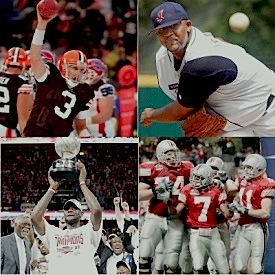 A stunning collapse in the ALCS; a disappointing sweep in the NBA Finals; a 10-win team missing the NFL Playoffs by a tiebreaker; and TWO embarrassing blowout losses to Florida in NCAA National Championship Games! To most fan bases, this would sound like one of the most disastrous calendar years on record. For Cleveland, it just might have been our finest hour. This was 2007, and yes, it feels a lot longer ago than that.
A stunning collapse in the ALCS; a disappointing sweep in the NBA Finals; a 10-win team missing the NFL Playoffs by a tiebreaker; and TWO embarrassing blowout losses to Florida in NCAA National Championship Games! To most fan bases, this would sound like one of the most disastrous calendar years on record. For Cleveland, it just might have been our finest hour. This was 2007, and yes, it feels a lot longer ago than that.
Obviously, a truly demoralizing sports climate like the one in which we currently find ourselves will result in a little of that "don't know what you got til it's gone" sort of hindsight. But there's something extra crushing about realizing just how recent this collective Cleveland sports slide has been.
The first time I conducted a revisitation of the 2007 sports calendar was in the immediate aftermath of "The Decision" back in 2010. In the two years since, the Browns, Indians, Cavs, and Buckeyes have only managed to float further from the shores of relevance-- reinforcing just how special their simultaneous excellence actually was a mere five years ago.
Compared to the euphoria of the Jacobs Field magic in 1995 or the rise of the Dawg Pound a decade earlier, 2007 seemed rather tame as we stood in the midst of it. Pessimistic outlooks have always been the norm around here, of course, so even as all of our beleaguered franchises seemed to be synchronizing their respective rebuilding processes into actual on-field success, the reaction from the fans was on a bit of a delay—like a satellite feed from the Middle East. Why, for example, should we have put our faith in a Cleveland Browns team that went 4-12 in 2006 when the same incompetent personnel was still in charge in 2007? And why would there be any reason to take an Indians team seriously when Eric Wedge’s club had fallen apart down the stretch in 2005 and stumbled to a 78-84 mark in ’06? At the Q, a not-yet-villainous LeBron James had become the focal point of the local sports universe, but even the most obnoxious of pipe-dreaming "witnesses" would have had a hard time believing a starting line-up with guys named "Sasha," "Boobie," and "Drew Gooden" could find its way to a championship. Down in Columbus, the Buckeyes were obvious title contenders, but that’s the case every year. No one was impressed. After all, it wasn't like Coach Tressel's job was ever going to be in jeopardy.
And so the stage was set for what, in retrospect, has to be considered among the most successful single years in Cleveland sports history— and ironically—the summit from which an avalanche of recent organizational failures began. If you're wondering why the record-breaking losing streaks of the past two years have stung perhaps even more than those of our youth, it may be because success is right there in the rear view mirror-- no further back in the memory banks than "No Country For Old Men" or Amy Winehouse singing "Rehab."
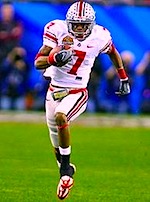 January
January
On January 8, 2007, the Ohio State Buckeyes marched into University of Phoenix Stadium in Glendale, Arizona, as the #1 ranked team in the country. It had been nearly seven weeks since they’d beaten a very good Michigan team in an all-time classic, 42-39, and now—finally—it was time to prove their worth for all the marbles against the best from the SEC, the Florida Gators. The goal was an undefeated season and the Bucks’ first National Championship in four years. And with the opening kickoff, it looked almost like an inevitability. Ted Ginn Jr. sprinted 93 yards to pay dirt, sending the OSU faithful into hysterics. Unfortunately, Ginn’s own teammate Roy Hall was also among the overexcited, sliding right into Ginn and spraining the speedster’s foot during the post-touchdown celebration. Ginn was out for the game, and the contest quickly devolved into the gridiron equivalent of Chinese water torture, as Chris Leak, Percy Harvin, and a frosh named Tim Tebow rolled to an embarrassing 41-14 shellacking of Jim Tressel’s squad. But hey, better that than the days of John Cooper’s Holiday Bowl triumphs, right?
 February
February
With just a couple months to go in the 2006-2007 NBA season, the James-led Cavaliers were not looking like world beaters. They began February at just 26-20, with the backcourt of Larry Hughes and Eric Snow inspiring more chuckles than fear. Still, if we can briefly force ourselves to look back on a man’s talents before they were transplanted to South Beach, we might fondly recall two big victories over the L.A. Lakers, just four days apart, in February of 2007. The second win, in particular, was a tone setter for the stretch run, as James dropped 38 on Kobe at the Staples Center the day after Valentines. Cleveland went 19-10 the rest of the way; good enough for 50 wins and a #2 seed in the playoffs.
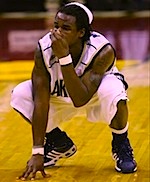 March
March
On March 10, 2007, those of us with Akron ties were glued to the MAC Championship Game between the Zips and Miami Redhawks. An automatic berth in the Big Dance was on the line, and it was also the last chance for LeBron’s St. V pals Romeo Travis and Dru Joyce III to claim a MAC title. Win or lose, it was already the best season in Akron basketball history: 26 wins, 6 losses. And with just seconds left on the clock and a two-point lead, it looked like it’d be 27. But after the Zips' normally reliable Cedric Middleton missed a critical free throw, Miami’s Doug Penno quickly raced down the floor and launched a Hail Mary three-pointer from 30 feet, banking it in just as the buzzer sounded. The result was ten minutes of absolute chaos, as referees put the play under intense review while both teams waited with their seasons in the balance. Eventually, the shot was determined good (even though the clock had started late after the Redhawk rebound), giving Miami a 53-52 win and denying Akron an NCAA tournament spot. Despite 26 wins, Akron somehow wasn’t even invited to the NIT.
One day later, as a nice pick-me-up, the Buckeyes beat Wisconsin to win the Big Ten title and a #1 seed in the NCAA tournament.
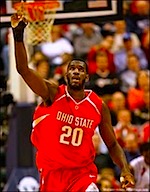 April
April
As the fates would have it, Ohio State got its crack at revenge against Florida much sooner than anyone expected. And while it wasn’t on the football field, it was in a football stadium—the Georgia Dome—for the 2007 NCAA Basketball Championship on April 2. Led by the amazing freshman class of Greg Oden, Mike Conley Jr., and Daequan Cook, the Buckeyes were 35-3 when they stared down Joakim Noah and the Gators in front of 50,000 spectators. It’s rare enough that a school advances to two major championship games in one calendar year; rarer still that they’d be opposed by the same school in both games; and just plain depressing that both games would have almost the identical result. Ohio State was thoroughly overmatched by the athletic Gators throughout, eventually falling 84-75. Shortly thereafter, the Bucks’ fab froshes all elected to go pro after one year, ending a potential dynasty before it ever started.
Several weeks later, the Cleveland Browns became the surprise talk of the NFL Draft, taking future Pro Bowler Joe Thomas with the #3 overall pick, and trading up to take a “franchise” quarterback in Notre Dame’s Brady Quinn at #22.
And at Jacobs Field, the Indians weathered a snowed out series with Seattle and wound up 14-8 in April—their best start ever under Eric Wedge.
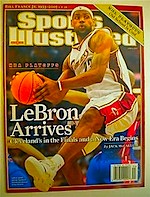 May
May
On May 21, the Cavs headed to Auburn Hills for the start of a hotly anticipated Eastern Conference Finals duel with their arch nemesis, the Detroit Pistons. A year earlier, Detroit had knocked LeBron and company out in the conference semi-finals. Now, they were the last obstacle between Cleveland and a first-ever NBA Finals berth. After falling down 2 games to 0, the Cavs fought back to even the series at home, then headed back to Detroit on May 31 for what became a legendary Game Five. In double overtime, the Cavs took control of the series with a 109-107 win that also served as LeBron’s coming out party as a Jordan-caliber superstar. LBJ’s 48 points included the last 25 points the Cavs scored in the game. All of ‘em. Cleveland went on to take the series in six.
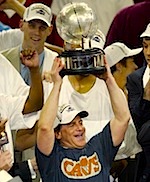 June
June
Of course, while Dan Gilbert happily raised the first Eastern Conference Championship trophy in his franchise's history, the Cavaliers' indoctrination into the NBA Finals experience wound up being a humbling one in the summer of ‘07. The first two games in San Antonio found LeBron and his merry men simply unable to handle the suffocating defense of the Spurs, nor the speed of Tony Parker. When the series moved to the Q, James did his best to generate some inspired comeback attempts that led to some nail-biting finishes. But on June 14, the Spurs dug in their claws during the last six minutes of Game Four, holding on for an 83-82 win and a series sweep. Cleveland was forced to watch the Spurs celebrate a championship on their own floor. Still, virtually everyone assumed this was a temporary setback. LeBron and an improved Cavs roster would surely return for another shot at a ring very soon.
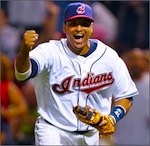 July
July
As Cleveland shook off its basketball hangover, the Indians headed to the All-Star break in 2007 in the thick of the pennant chase, just a game behind the defending American League champion Tigers. In the All-Star Game itself, the Tribe was represented by eventual Cy Young Award winner CC Sabathia along with rising superstars Grady Sizemore and Victor Martinez. V-Mart hit a 2-run homer that proved to be the game winner for the American League. Weeks later, at the trade deadline, Cleveland swung a deal for an old friend from those magical days in the mid ‘90s, as Kenny Lofton returned and proved to be a spark plug during the final two months and into the postseason.
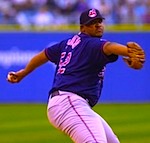 August
August
On August 29, while in first place and facing the division rival Twins in a match-up of aces (Sabathia vs. Johan Santana), the Indians only managed to draw 27,000 spectators through the Jacobs Field turnstiles. This year, that would qualify as a fantastic turnout, but in 2007, it was an early warning sign that a fan base was growing increasingly skeptical and cynical about its team-- even when they were in the midst of some prolonged, late-season success. Sabathia and the Indians won the game 4-3, moving to 75-57 on the season. And in this case, it was no fluke.
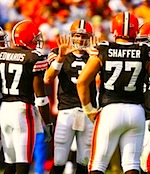 September
September
And indeed, in front of a much larger crowd on September 23, Jake Westbrook got the W in a 6-2 Tribe victory over Oakland, clinching the Central Division title and the Indians' first playoff berth in six years. A week later, they wrapped up the regular season at 96-66, tied with the Red Sox for the best record in baseball.
Meanwhile, strange things were happening on the lakefront. Despite winning a long, drawn out QB competition in the preseason, Akron grad Charlie Frye was unceremoniously dumped after an Opening Day thumping at the hands of Pittsburgh. In his place, Romeo Crennel handed the reins over to former Ravens castoff Derek Anderson. To the amazement of Planet Earth, Anderson responded by torching the Bengals for 328 yards and 5 touchdowns on September 16, earning AFC Player of the Week honors in his debut as the Browns starter. With Braylon Edwards, Kellen Winslow, and Jamal Lewis also having big days, Cleveland suddenly looked like it had some serious offensive potential.
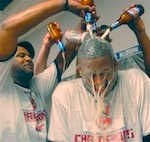 October
October
So yeah, are you starting to hate yourself for taking these things for granted yet? Less than five years ago, we had a playoff-bound baseball team, an entertaining football team with a winning record, and a basketball team fresh off an NBA Finals appearance. Holy shit! What the f*%# happened?!
Maybe it all started with Game Five of the American League Championship Series at Jacobs Field: October 18, 2007. After advancing past the Yankees in the Division Series (with an assist from a hoard of midges), the Indians continued their torrid autumn against Boston, rallying off three straight wins to take a commanding 3 games to 1 lead, with Game Five at home and Sabathia on the bump. We all know how this played out, of course. CC pulled a LeBron (formerly known as a CC) and let Boston walk all over him, 7-1. In Game Six, the previously unhittable "Fausto Carmona" suddenly showed signs of the headcase he would eventually become, as the entire series completely unravled in disastrous fashion. After sitting in the driver’s seat, the Tribe choked away the last three games of the ALCS by a combined score of 30-5! The Red Sox went on to the World Series and made quick work of the Rockies to win their second title in four years. Again, though, we didn’t really fret too much. After all, our team was young, and top talents like Cliff Lee and Shin-Soo Choo hadn’t even been involved in that series. The theory was, a few tweaks in the offseason, and the Indians would be right back in the hunt again.
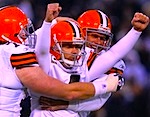 November
November
Admittedly a little depressed from the playoff losses of the Indians... and the Cavs... and the Buckeyes... and hell, the Zips too... it was time to put our 2007 eggs in the unlikely basket of Derek Anderson and the Browns. And in November, they seemed remarkably poised to carry that load. Cleveland went 3-1 in the month, including a heartbreaking 3-point loss at Pittsburgh that at least showed just how competitive this team had become. November 18 topped them all, though. This was the infamous Dawson Deflection game, as the Browns snuck by Baltimore 33-30 in OT after Phil Dawson’s last second field goal was revealed to have hit the goal post before bouncing back through the uprights. When things like that start going our way, you know it’s a special year.
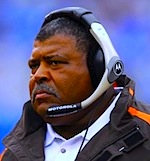 December
December
That said, 2007 ended about as appropriately as it could given all we know about Cleveland sports. On December 30, the Cavs were scuffling a bit but still poised for another playoff run. The Indians were relatively quiet on the hot stove front, confident that they already had the pieces in place to take the next step in 2008. Ohio State had beaten Michigan as usual and was elected by the BCS robots to play for the National Championship again in January (this time it was against LSU, but the result would be sickeningly similar). And then there were the Browns. After failing to lock up a playoff spot a week earlier against Cincinnati, Cleveland beat the 49ers on December 30 to finish the season with a still very impressive record of 10-6; the team’s best mark since 1994 and still their greatest showing of the expansion era. Unfortunately, a playoff berth still depended on outside forces—namely, the Colts had to beat the Titans that night. Normally, this would be easy money, but with their playoff spot secure, Indianapolis benched Peyton Manning and virtually every other starter, leaving the Browns’ fate in the hands of QB Jim Sorgi and a rag tag crew of fill-ins. Despite having won 6 straight games coming in, the Colts naturally lost 16-10, and the ridiculously small window of the Crennel era Browns was shut and sealed forever. It was a rough New Years Eve for Cleveland sports fans.
In Hindsight: Glory or Gut Punch?
So, was 2007 a nightmarish march to a psychological slaughterhouse or a thrilling spectacle of remarkably competent and often inspiring performances? If we judge merely by the final results, it may indeed look more like someone jabbing a thumb mercilessly into your eyeball for twelve months. But on closer inspection, 2007 was about as glorious as our sports world gets, and if we’re honest with ourselves, we’d give anything to be back there. Just think about this:
Looking at 2007 alone, the Indians, Browns, Cavs, and Buckeyes (football and basketball) combined to go 187-112 in regular season play (a .625 winning percentage) and 26-15 across a whopping 41 postseason contests (.634). Sure, not a single one of those playoff games ended with a world championship trophy presentation (for the good guys, anyway), but for pure entertainment value, it’s hard to fathom another year like that in any sports future we’re likely to see. So... 2007? Who knew?
- NBA Announces 2013-2014 Schedule
- Browns Ink Sharknado
- Sharknado A No-Show For Rookie Camp
- Trent Richardson Out Until Training Camp
- Browns Sign Brandon Jackson
- Carrasco Suspended Eight Games
- Browns Add to Wide Receiver Depth with David Nelson
- Browns Need to Learn from Past Draft Mistakes
- Browns Release Chris Gocong and Usama Young
- Browns Missing on Grimes Disappointing, But Not The End
The TCF Forums
- Movies coming out
rebelwithoutaclue (Tuesday, January 21 2014 12:56 PM) - 2015 Recruiting
jclvd_23 (Tuesday, January 21 2014 12:38 PM) - The 2014 Offseason Thread
Larvell Blanks (Tuesday, January 21 2014 12:25 PM) - Official- Browns Coach Search/Rumors
Larvell Blanks (Tuesday, January 21 2014 11:53 AM) - Chris Grant's first 3 drafts
Kingpin74 (Tuesday, January 21 2014 10:13 AM) - Mike Brown
YahooFanChicago (Monday, January 20 2014 11:15 PM) - 2014 Hoops Hockey Hijinx
jpd1224 (Monday, January 20 2014 4:44 PM) - 2014 Recruiting
jclvd_23 (Monday, January 20 2014 2:26 PM) - Wish List - #4 Pick
Hikohadon (Monday, January 20 2014 1:26 PM) - #1 overall pick Anthony Bennett
TouchEmAllTime (Sunday, January 19 2014 1:28 PM)



